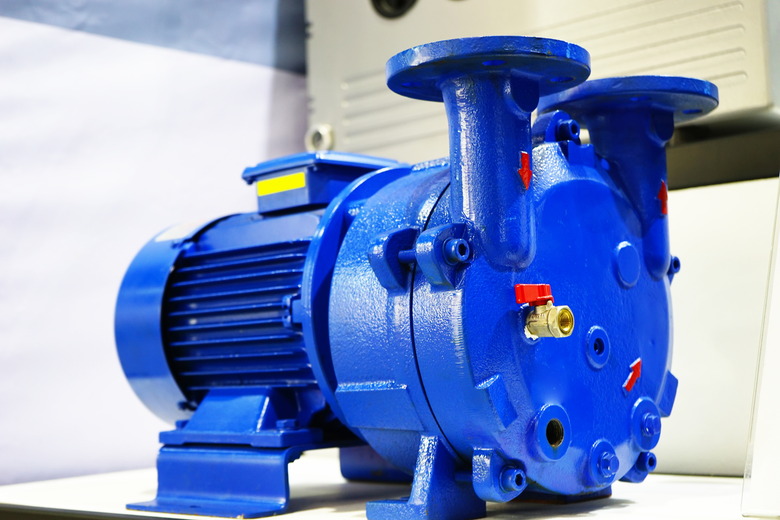How To Calculate The Suction Pressure Of A Pump
If you're being asked to find the suction pressure of a pump, there are two ways to interpret that request. The first is pressure per square inch or "psi," which is what most people mean when they talk about pressure; this measures the force applied to an area. (1 pound of force applied to 1 square inch of area = 1 psi.) But if pumps are the topic in question, you might actually need to find the "head," which refers to how high the pump can raise a vertical column of liquid.
Differentiating Between Psi and Head
Differentiating Between Psi and Head
Psi and head are, at their roots, two different ways of discussing the same thing: The power of your pump. So why have two different takes on the same concept? That's because not all liquids weigh the same, and the psi of your pump will change depending on the weight of the liquid flowing through it. But the head – remember, that's the distance that pump can elevate a column of liquid – won't change. So when it comes to pumps, life is a lot simpler if you discuss their power in terms of "head."
The Psi and Suction Head Calculation
The Psi and Suction Head Calculation
Both psi and head are typically measured by the manufacturer, but if you have one of these elements and need the other, the conversion is simple. Assuming that you're dealing with water, which has a specific gravity of 1.0, then the following equations apply:
head (in feet) = psi × 2.31
psi = head (in feet) ÷ 2.31
So if you have a pump that operates at 20 psi, its head is 20 × 2.31 = 46.2 feet.
Whereas if you have a pump whose head is 100 feet, its psi is 100 ÷ 2.31 = 43.29 psi.
What About Other Liquids?
What About Other Liquids?
There's a secret stowaway in those equations for converting from head to pressure and back again: The specific gravity of the liquid you're pumping. If you include the specific gravity, the equations look like this:
head (in feet) = (psi × 2.31)/specific gravity
psi = (head [in feet] × specific gravity)/2.31
Because the specific gravity of water is 1.0, it doesn't affect the value of either equation. But if you deal with a non-water liquid, remember to take the specific gravity of that liquid into account.
What About NPSH?
What About NPSH?
The previous two measurements – psi and head – are all you need to compare the relative strength and suitability of pumps for various applications. But if you're delving deeper into the technical specs of the pump itself, you might also need to find net positive suction head, or NPSH, which measures the pressure at the suction port of the pump.
There are two types of NPSH; NPSHR is the minimum pressure required to prevent cavitation, which can ruin or shorten the life your pump. This specification is provided by the manufacturer. So the type of NPSH you may be asked to calculate is NPSHA, or the absolute pressure at the pump's suction port.
In order to calculate NPSHA, you're going to need some detailed specifications for not just your pump, but the system it's working in. In most word problems, you'll either be given this information or enough data to figure it out:
- Absolute pressure at the surface of the supply liquid (expressed in head).
- The vertical distance from the surface of the supply liquid to the centerline of the pump (can be positive or negative, usually expressed in feet or head).
- Friction losses inside the pipe (often figured from charts).
- Absolute vapor pressure of the liquid at pumping temperature.
Once you've assembled that information, calculating NPSHA is as simple as addition and subtraction:
NPSHA = absolute pressure ± vertical distance – friction losses – absolute vapor pressure
Some equations will also include the velocity head at the pump's suction port, but it's so small that it's often left out.
Cite This Article
MLA
Maloney, Lisa. "How To Calculate The Suction Pressure Of A Pump" sciencing.com, https://www.sciencing.com/how-7726588-calculate-suction-pressure-pump/. 26 November 2018.
APA
Maloney, Lisa. (2018, November 26). How To Calculate The Suction Pressure Of A Pump. sciencing.com. Retrieved from https://www.sciencing.com/how-7726588-calculate-suction-pressure-pump/
Chicago
Maloney, Lisa. How To Calculate The Suction Pressure Of A Pump last modified March 24, 2022. https://www.sciencing.com/how-7726588-calculate-suction-pressure-pump/
